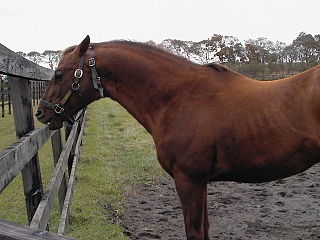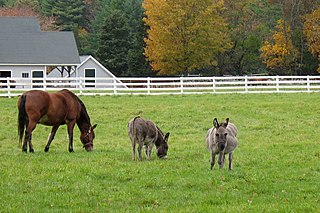
Debeaking, beak trimming, or beak conditioning is the partial removal of the beak of poultry, especially layer hens and turkeys although it may also be performed on quail and ducks. Most commonly, the beak is shortened permanently, although regrowth can occur. The trimmed lower beak is somewhat longer than the upper beak. A similar but separate practice, usually performed by an avian veterinarian or an experienced birdkeeper, involves clipping, filing or sanding the beaks of captive birds for health purposes – in order to correct or temporarily to alleviate overgrowths or deformities and better allow the bird to go about its normal feeding and preening activities. Amongst raptor-keepers, this practice is commonly known as "coping".
A stereotypy is a repetitive or ritualistic movement, posture, or utterance. Stereotypies may be simple movements such as body rocking, or complex, such as self-caressing, crossing and uncrossing of legs, and marching in place. They are found especially in people with autism spectrum disorders and visually impaired children, and are also found in intellectual disabilities, tardive dyskinesia and stereotypic movement disorder, yet may also be encountered in neurotypical individuals as well. Studies have shown stereotypies associated with some types of schizophrenia. Frontotemporal dementia is also a common neurological cause of repetitive behaviors and stereotypies. Several causes have been hypothesized for stereotypy, and several treatment options are available.

Feather-plucking, sometimes termed feather-picking, feather damaging behaviour or pterotillomania, is a maladaptive, behavioural disorder commonly seen in captive birds that chew, bite or pluck their own feathers with their beak, resulting in damage to the feathers and occasionally the skin. It is especially common among parrots, with an estimated 10% of captive parrots exhibiting the disorder. The areas of the body that are mainly pecked or plucked are the more accessible regions such as the neck, chest, flank, inner thigh and ventral wing area. Contour and down feathers are generally identified as the main target, although in some cases, tail and flight feathers are affected. Although feather-plucking shares characteristics with feather pecking commonly seen in commercial poultry, the two behaviours are currently considered to be distinct as in the latter, the birds peck at and pull out the feathers of other individuals.
An ethogram is a catalogue or inventory of behaviours or actions exhibited by an animal used in ethology.
Self-cannibalism is the practice of eating parts of one's own body, also called autocannibalism or autosarcophagy. Generally, only the consumption of flesh by an individual of the same species is considered cannibalism. In line with this usage, self-cannibalism means the consumption of flesh from one's own body. While some texts use this strict definition, others use the term autocannibalism in a wider sense that includes the consumption of hair or nails from one's own body.

Cribbing is a form of stereotypy, otherwise known as wind sucking or crib-biting. Cribbing is considered to be an abnormal, compulsive behavior seen in some horses, and is often labelled a stable vice. The major factors that cause cribbing include stress, stable management, genetic and gastrointestinal irritability.

Horse behavior is best understood from the view that horses are prey animals with a well-developed fight-or-flight response. Their first reaction to a threat is often to flee, although sometimes they stand their ground and defend themselves or their offspring in cases where flight is untenable, such as when a foal would be threatened.
Autophagia refers to the practice of biting/consuming one's body. It is a sub category of self-injurious behavior (SIB). Commonly, it manifests in humans as nail biting and hair pulling. In rarer circumstances, it manifests as serious self mutilative behavior such as biting off one's fingers. Autophagia affects both humans and non humans. Human autophagia typically occurs in parts of the body that are sensitive to pain, such as fingers. Human autophagia is not motivated by suicidal intent, but may be related to the desire to seek pain.

Cannibalism is the act of consuming another individual of the same species as food. Cannibalism is a common ecological interaction in the animal kingdom and has been recorded in more than 1,500 species. Human cannibalism is well documented, both in ancient and in recent times.

Savaging is a term used in the study of ethology that refers to aggressive behaviour displayed by the mother towards the offspring. Aggressive behaviour includes being rough with, injuring, biting, attacking, crushing and killing of the offspring. While savaging behaviour has been seen in multiple species, it is predominantly demonstrated in domestic pigs. As the definition of savaging is so broad, research on the prevalence of savaging behaviour varies with reports of little savaging of offspring to savaging of offspring up to the 20th percentile. Prevalence of aggressive, non-fatal savaging is greater in gilts, or females who have not yet previously farrowed, as piglet-focused aggression is more frequent in young animals than sows, adult females who have previously given birth. Occurrence of savaging demonstrated by sows is greater if the sow has previously savaged her offspring either as a gilt or sow. Savaging behaviour usually occurs during the first two days after parturition. Prevalence of savaging is similar among first and second farrowing cycles. Savaging behaviour has a significant impact on both agricultural economy and animal welfare which is why it is currently a subject of interest in the pig industry.

Stable vices are stereotypies of equines, especially horses. They are usually undesirable habits that often develop as a result of being confined in a stable with boredom, hunger, isolation, excess energy, or insufficient exercise. They present a management issue, not only leading to facility damage from chewing, kicking, and repetitive motion, but also leading to health consequences for the animal if not addressed. They also raise animal welfare concerns.
Animal psychopathology is the study of mental or behavioral disorders in non-human animals.

In animal behaviour, stereotypy, stereotypic or stereotyped behaviour has several meanings, leading to ambiguity in the scientific literature. A stereotypy is a term for a group of phenotypic behaviours that are repetitive, morphologically identical and which possess no obvious goal or function. These behaviours have been defined as 'abnormal', as they exhibit themselves solely in animals subjected to barren environments, scheduled or restricted feedings, social deprivation and other cases of frustration, but do not arise in 'normal' animals in their natural environments. These behaviours may be maladaptive, involving self-injury or reduced reproductive success, and in laboratory animals can confound behavioural research. Stereotypical behaviours are thought to be caused ultimately by artificial environments that do not allow animals to satisfy their normal behavioural needs. Rather than refer to the behaviour as abnormal, it has been suggested that it be described as "behaviour indicative of an abnormal environment".

Feather pecking is a behavioural problem that occurs most frequently amongst domestic hens reared for egg production, although it does occur in other poultry such as pheasants, turkeys, ducks, broiler chickens and is sometimes seen in farmed ostriches. Feather pecking occurs when one bird repeatedly pecks at the feathers of another. The levels of severity may be recognized as mild and severe. Gentle feather pecking is considered to be a normal investigatory behaviour where the feathers of the recipient are hardly disturbed and therefore does not represent a problem. In severe feather pecking, however, the feathers of the recipient are grasped, pulled at and sometimes removed. This is painful for the receiving bird and can lead to trauma of the skin or bleeding, which in turn can lead to cannibalism and death.

Abnormal behavior of birds in captivity has been found to occur among both domesticated and wild birds. Abnormal behavior can be defined in several ways. Statistically, 'abnormal' is when the occurrence, frequency or intensity of a behaviour varies statistically significantly, either more or less, from the normal value. This means that theoretically, almost any behaviour could become 'abnormal' in an individual. Less formally, 'abnormal' includes any activity judged to be outside the normal behaviour pattern for captive birds of that particular class or age. For example, running rather than flying may be a normal behaviour and regularly observed in one species, however, in another species it might be normal but becomes 'abnormal' if it reaches a high frequency, or in another species it is rarely observed and any incidence is considered 'abnormal'. This article does not include 'one-off' behaviours performed by individual birds that might be considered abnormal for that individual, unless these are performed repeatedly by other individuals in the species and are recognised as part of the ethogram of that species.
Toe pecking, an abnormal behaviour of birds in captivity, occurs when one bird pecks the toes of another using its beak. This behaviour has been reported in hens and ostriches. Studies have shown that hens exposed to toe pecking have significantly enlarged adrenal glands, indicating increased physiological stress. Hens exposed to toe pecking will step off a raised platform more quickly than control hens, possibly suggesting a heightened fear of elevation. They have also been reported to show depressive behaviour when afflicted by toe-pecking. The act of toe pecking leads to open wounds which are viable for infection and disease to develop. In severe forms, toe pecking can be classified as a cannibalistic behaviour and has been reported as a cause of mortality.
Animal welfare science is the scientific study of the welfare of animals as pets, in zoos, laboratories, on farms and in the wild. Although animal welfare has been of great concern for many thousands of years in religion and culture, the investigation of animal welfare using rigorous scientific methods is a relatively recent development. The world's first Professor of Animal Welfare Science, Donald Broom, was appointed by Cambridge University (UK) in 1986.

Cannibalism in poultry is the act of one individual of a poultry species consuming all or part of another individual of the same species as food. It commonly occurs in flocks of domestic hens reared for egg production, although it can also occur in domestic turkeys, pheasants and other poultry species. Poultry create a social order of dominance known as pecking order. When pressure occurs within the flock, pecking can increase in aggression and escalate to cannibalism. Cannibalism can occur as a consequence of feather pecking which has caused denuded areas and bleeding on a bird's skin. Cannibalism can cause large mortality rates within the flock and large decreases in production due to the stress it causes. Vent pecking, sometimes called 'cloacal cannibalism', is considered to be a separate form of cannibalistic pecking as this occurs in well-feathered birds and only the cloaca is targeted. There are several causes that can lead to cannibalism such as: light and overheating, crowd size, nutrition, injury/death, genetics and learned behaviour. Research has been conducted to attempt to understand why poultry engage in this behaviour, as it is not totally understood. There are known methods of control to reduce cannibalism such as crowd size control, beak trimming, light manipulation, perches, selective genetics and eyewear.

Lignophagia is the abnormal behaviour of chewing and eating wood. It has been recorded in several species, but perhaps most commonly in horses where it is usually called, simply, "wood chewing". Lignophagia is a form of the pica disorder, in which normally non-nutritive substances are chewed or eaten. For some animals, wood is the normal primary food source; such animals are known as being xylophagous.
Christine Nicol is an author, academic and a researcher. She is a Professor of Animal Welfare at the Royal Veterinary College and has honorary appointments at the University of Oxford and the University of Lincoln. She is the Field Chief Editor of Frontiers in Animal Science.












